The Process of Alchemy (Part 4 – Finishing and Assembly)
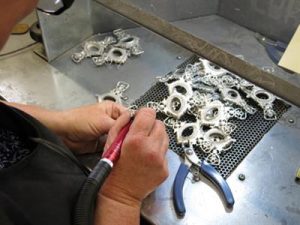 It is commonly believed that Alchemy’s pewter jewellery and giftware is probably made in China in some large automated factory, however, we are very proud to boast that all of our pewter products have always been and always will be designed, developed and made from true English Pewter, under one roof in our own studios and workshops in Leicester, England.
It is commonly believed that Alchemy’s pewter jewellery and giftware is probably made in China in some large automated factory, however, we are very proud to boast that all of our pewter products have always been and always will be designed, developed and made from true English Pewter, under one roof in our own studios and workshops in Leicester, England.
And so, after casting the parts, the process continues…
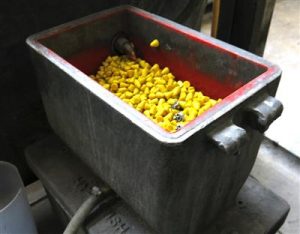 Following casting each batch of the dull, white metal components is taken to the fettling bench, where keen and dextrous craftspeople individually handle each part, first to be inspected and then trimmed and cleaned-up using a variety of precision hand tools. This is an important part of the process which goes towards defining the quality of a finished piece, which in massed produced products tends to be missed altogether.
Following casting each batch of the dull, white metal components is taken to the fettling bench, where keen and dextrous craftspeople individually handle each part, first to be inspected and then trimmed and cleaned-up using a variety of precision hand tools. This is an important part of the process which goes towards defining the quality of a finished piece, which in massed produced products tends to be missed altogether.
The castings then go to the finishing department where, depending on the particular finishes proposed for each piece chosen from a wide menu, all custom-developed by Alchemy, they will go through the first of many stages of treatment in a vibro finishing tub or a tumbler, in a similar fashion to those of gold and silver jewellery.
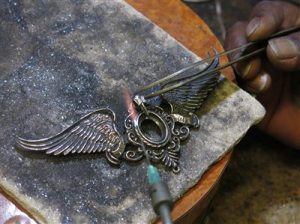 This is usually a preliminary process, done in component form prior to any multi-part assembly. Various different vibro and other machines are used with a wide variety of media, including ceramic, hard plastics and steel, and their accompanying chemical compounds, and all using individual settings which achieve an infinite diversity of possible combinations of finish.
This is usually a preliminary process, done in component form prior to any multi-part assembly. Various different vibro and other machines are used with a wide variety of media, including ceramic, hard plastics and steel, and their accompanying chemical compounds, and all using individual settings which achieve an infinite diversity of possible combinations of finish.
Once the components are processed they will be taken into the assembly room for Alchemy’s skilled jewellers to begin constructing each final objective. Soldering very small components made from such low melting point alloys is a fiendishly difficult job, and requires exceptional skills. However, depending upon each individual piece and its materials, various precise assembly methods are used including riveting, spinning and various types of special gluing.
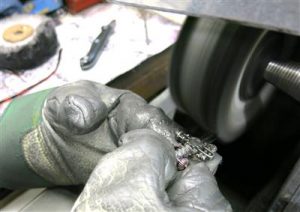 When an item is almost complete it is next likely to go down to the polishing shop, where highly skilled polishers using a wide variety of polishing compounds and wheels, etc, will apply a lustrous hand finish. Often, in order to achieve a two or a three tone appearance, one or more components will also be given a plated finish of copper-bronze, oxide black or gilt-brass, etc.
When an item is almost complete it is next likely to go down to the polishing shop, where highly skilled polishers using a wide variety of polishing compounds and wheels, etc, will apply a lustrous hand finish. Often, in order to achieve a two or a three tone appearance, one or more components will also be given a plated finish of copper-bronze, oxide black or gilt-brass, etc.
Such parts will return once more to the assembly room for their decisive fabrication, and then finally into the spray shop for a protective lacquering.
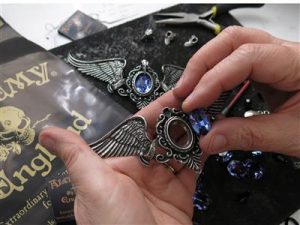 There is then one more, vitally important process; light assembly, where nimble-fingered technicians fit the findings such as carefully chosen Swarovski crystals and add the chains, ribbons, ear wires and so-on, all delicately applied before quality control and then packing, to complete the finished product.
There is then one more, vitally important process; light assembly, where nimble-fingered technicians fit the findings such as carefully chosen Swarovski crystals and add the chains, ribbons, ear wires and so-on, all delicately applied before quality control and then packing, to complete the finished product.
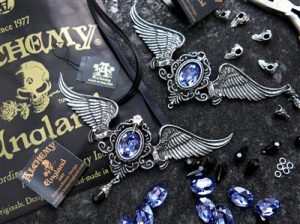 It is to be hoped that the level of, time pride and skill and enjoyment that actually goes into making even the simplest of Alchemy England pieces might now be more appreciated for what it is, and loved as much by the new owner as it is by its creators.
It is to be hoped that the level of, time pride and skill and enjoyment that actually goes into making even the simplest of Alchemy England pieces might now be more appreciated for what it is, and loved as much by the new owner as it is by its creators.
Thank you for your interest!
The Alchemy Editorial Team
www.alchemyengland.com
